Gantry Crane: The Complete Handbook for Workstation Gantry Cranes
Precision in Motion: The Complete Handbook for Workstation Gantry Cranes
Workstation gantry cranes stand as versatile and indispensable tools across various industrial landscapes, serving as pivotal elements in enhancing operational precision, efficiency, and safety. These robust systems, designed with precision in mind, offer a seamless combination of functionality and maneuverability, catering to the diverse needs of numerous industries.
Definition and Purpose of Workstation Gantry Cranes
Workstation gantry cranes, also known as gantry or bridge cranes, are overhead material handling systems featuring a horizontal beam (bridge) supported by two upright legs (gantry) that traverse along a fixed path. They are specifically engineered to handle heavy loads within confined workspaces, providing exceptional control and precision during lifting, lowering, and maneuvering operations.
The primary purpose of these cranes is to facilitate the movement and placement of materials or equipment with pinpoint accuracy, optimizing workflow efficiency while reducing manual labor and the risk of workplace injuries. They can be customized to accommodate different load capacities, ranging from smaller, lightweight items to heavier materials, depending on the specific needs of the industry or application.
Overview of "Precision in Motion" and Efficiency
"Precision in Motion" epitomizes the core essence of workstation gantry cranes. These systems operate with meticulous accuracy, ensuring that loads are handled with finesse and control. The bridge and trolley mechanisms allow for seamless horizontal movement, while the hoisting features enable precise vertical lifting and placement, guaranteeing items are precisely positioned at desired locations.
Efficiency is another hallmark of workstation gantry cranes. These systems are designed to optimize workflows by streamlining material handling processes. Their ability to swiftly and precisely move loads minimizes downtime, ultimately bolstering productivity and output in diverse industrial settings.
Significance of Workstation Gantry Cranes in Various Industries
The versatility of workstation gantry cranes extends across a spectrum of industries, including manufacturing, warehousing, maintenance, and beyon In manufacturing, they play a vital role in assembly lines, aiding in the precise positioning of components or finished products. Warehousing and logistics benefit from their efficiency in managing inventory and facilitating swift material handling.
Maintenance and service facilities utilize these cranes for tasks like equipment maintenance or engine overhaul, allowing technicians to position heavy machinery precisely for maintenance or repairs. Their adaptability across diverse industries underscores their significance as a cornerstone of operational efficiency and safety.
In the subsequent parts of this handbook, we will delve deeper into the myriad aspects of workstation gantry cranes, exploring their components, applications, capacities, technological advancements, safety measures, and more, emphasizing the essence of precision in motion for optimized industrial operations.
Benefits and Advantages of Workstation Gantry Cranes
Workstation gantry cranes stand out in the industrial landscape owing to a plethora of benefits and advantages they offer, catering to the intricate needs of various sectors. Their utilization transcends mere material handling; they become indispensable assets in ensuring operational efficiency, safety, and economic viability.
- Increased Precision and Handling Efficiency-Precision remains at the core of workstation gantry cranes. These systems are engineered with an acute focus on precise load handling. The ability to position heavy or delicate items with pinpoint accuracy streamlines production processes, reduces errors, and ensures consistent quality across operations. Their horizontal and vertical movement mechanisms enable operators to maneuver loads with unparalleled precision, enhancing overall handling efficiency.
- Safety Features for Seamless Operations-Ensuring a safe working environment is paramount in any industrial setting. Workstation gantry cranes are equipped with advanced safety features that mitigate potential hazards during operations. These include overload protection systems, emergency braking mechanisms, limit switches, and precision controls that prevent collisions or accidents. Such safety measures not only protect personnel but also safeguard valuable equipment and materials from damage.
- Adaptability and Customization for Diverse Tasks- One of the standout characteristics of workstation gantry cranes is their adaptability to diverse tasks. These systems can be customized to meet specific industry needs, accommodating varying load capacities, spans, and lifting heights. Whether handling heavy machinery in manufacturing or precise components in assembly lines, their adaptability ensures seamless integration into different workflows, maximizing operational efficiency.
- Economic and Productivity Advantages-The adoption of workstation gantry cranes presents substantial economic and productivity advantages. By optimizing material handling processes, these cranes minimize downtime, increase throughput, and reduce reliance on manual labor. The resultant boost in productivity leads to cost savings and enhanced profitability. Additionally, their efficiency in utilizing available workspace translates to higher overall efficiency, contributing significantly to the bottom line.
The multifaceted advantages offered by workstation gantry cranes form the backbone of their widespread adoption across industries. Their ability to amalgamate precision, safety, adaptability, and economic benefits makes them indispensable tools for optimizing industrial operations. In the subsequent sections, we will delve deeper into the technical components, diverse applications, and specialized capacities of these remarkable systems.
Components and Design of Workstation Gantry Cranes
Understanding the intricate components and design aspects of workstation gantry cranes unveils the engineering brilliance behind their precision and adaptability. This section delves into the foundational elements that contribute to the seamless functionality of these systems.
- Structural Elements: Gantry Frames and Supports-The robust structural framework of workstation gantry cranes comprises gantry frames and supports, forming the foundation for their stability and load-bearing capacity. These elements are typically constructed from durable materials like steel or aluminum, engineered to withstand heavy loads while maintaining structural integrity. Gantry frames provide the necessary rigidity, while the supports ensure stability and proper weight distribution, crucial for safe and efficient operations.
- Hoisting Mechanisms and Load Control- Central to the functionality of workstation gantry cranes are their hoisting mechanisms and load control features. These components facilitate the vertical movement of loads with precision and safety. The hoisting mechanisms often incorporate electric chain hoists or wire rope hoists, each offering varying load capacities and speed control options. Load control systems, such as limit switches and load sensors, ensure that the crane operates within safe parameters, preventing overloading and ensuring smooth lifting and lowering of materials.
- Trolley and Bridge Configurations-The trolley and bridge configurations define the horizontal movement capabilities of workstation gantry cranes. The bridge, spanning the width of the gantry, facilitates the movement of the trolley along the crane's length. Trolleys are equipped with wheels or tracks, allowing them to traverse smoothly across the bridge. These configurations enable the crane to cover the workspace efficiently, reaching various points to pick up, move, or place loads with precision.
- Integration of Advanced Control Systems for Precision-The modernization of workstation gantry cranes involves the integration of advanced control systems that optimize precision and operational efficiency. These systems often include variable frequency drives (VFDs), radio-frequency remote controls, or even automated systems driven by IoT (Internet of Things) technology. VFDs ensure smooth acceleration and deceleration, enhancing control over load movement. Remote control functionalities provide operators with increased flexibility and precision, enabling them to maneuver loads from a safe distance. IoT-driven systems enable data collection and analysis, allowing for predictive maintenance and performance optimization.
The meticulous design and integration of these components in workstation gantry cranes culminate in systems that not only facilitate precise material handling but also pave the way for technological advancements driving efficiency and safety in modern industrial operations. In the subsequent sections, we will explore the diverse applications and specialized features of these cranes across various industries.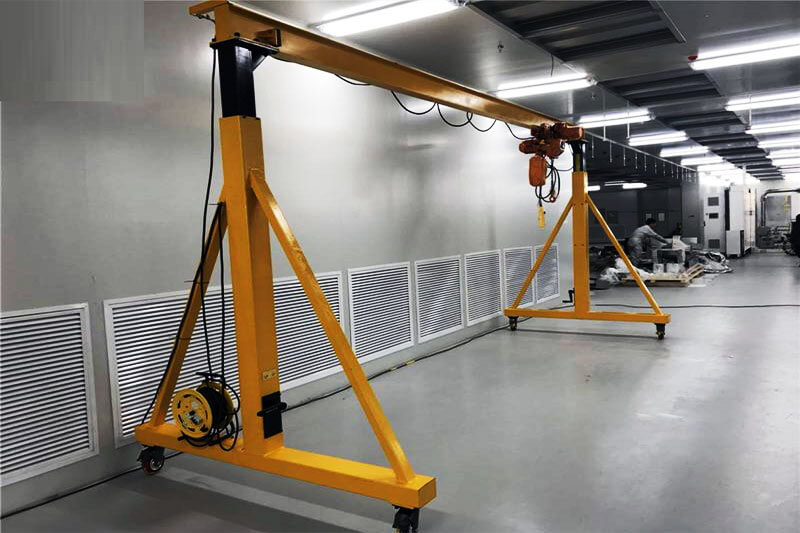
Portable Workstation Gantry Cranes:
- Features:These cranes are designed for mobility, often featuring wheels or casters for easy relocation within a workspace. They're typically lightweight yet robust, facilitating quick assembly and disassembly.
- Applications:Ideal for job sites requiring flexibility in moving loads across different locations within a facility. They're commonly used in workshops, maintenance areas, or construction sites for lifting and positioning various materials or equipment.
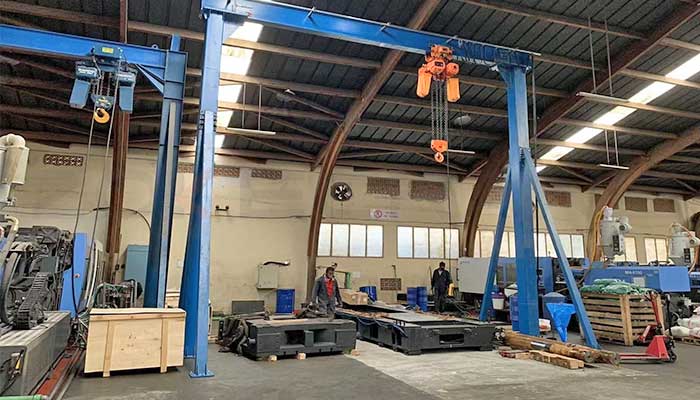
Fixed workstation gantry crane
Fixed Workstation Gantry Cranes:
- Features:These cranes are permanently installed in a specific location and are more robustly constructe They offer higher load capacities and stability compared to portable models.
- Applications:Well-suited for dedicated workstations within manufacturing or production facilities where consistent and repetitive lifting tasks are require They efficiently handle heavier loads and are integrated into assembly lines or specific workstations.
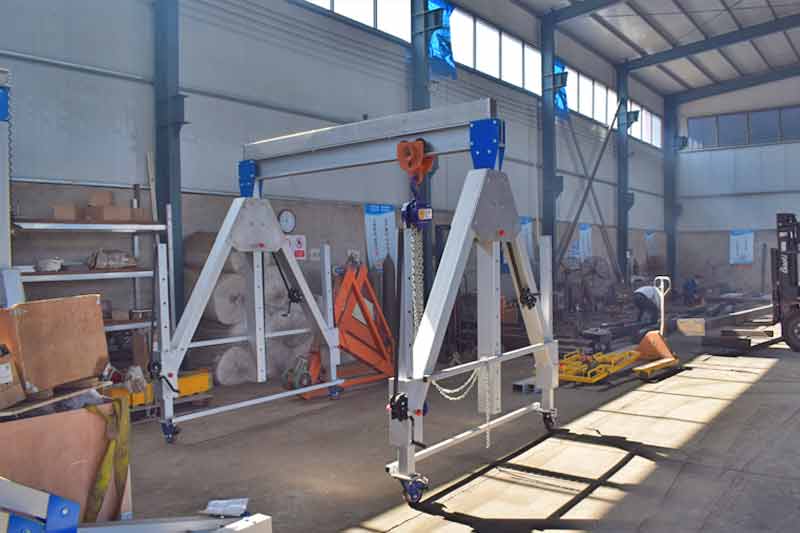
Adjustable Height Workstation Gantry Cranes:
- Features:These cranes feature adjustable heights, allowing operators to modify the lifting height to suit different tasks or environments.
- Applications:Ideal for versatile work settings where varying lifting heights are neede Commonly used in environments such as warehouses, workshops, or assembly lines where lifting needs might change.
Customizable Workstation Gantry Cranes:
- Features:These cranes are designed with modular components, allowing for customization based on specific requirements, such as different spans, lifting capacities, or additional features.
- Applications:Tailored for industries with unique lifting demands that may not be met by standard cranes. They're adaptable to specific load sizes, operational conditions, or spatial constraints.
The applications of workstation gantry cranes vary depending on their type and features:
- Manufacturing and Production Lines:Used for precise positioning of components during assembly or handling heavy machinery.
- Warehousing and Logistics:Efficiently manage inventory, load/unload trucks, and transport materials within storage facilities.
- Maintenance and Service Industries:Aid in equipment maintenance, repairs, and engine overhaul by providing precise positioning and lifting capabilities.
- Construction Sites:Portable gantry cranes assist in moving materials and equipment in confined spaces or on job sites.
These cranes offer a balance between portability, precision, and load-bearing capacity, making them valuable assets across industries where efficient material handling and precise load positioning are critical. Their versatility in various applications ensures enhanced productivity and safety in diverse work environments.
Comparisons of each types of workstation gantry cranes
Portable Workstation Gantry Crane vs Fixed Workstation Gantry Crane:
- Mobility:Portable gantry cranes are mobile and can be moved to different locations within a facility. Fixed gantry cranes are permanently installed at a specific location and cannot be easily relocate
- Capacity:Fixed gantry cranes generally have higher load capacities compared to portable ones due to their sturdier construction.
- Applications:Portable cranes are suitable for tasks requiring flexibility and relocation, whereas fixed cranes are ideal for dedicated workstations with consistent lifting needs.
Adjustable Height Workstation Gantry Crane vs Customizable Workstation Gantry Crane:
- Height Adjustability:Adjustable height cranes allow operators to modify the lifting height, offering versatility. Customizable cranes feature modular components allowing customization in terms of span, capacity, or additional features.
- Applications:Adjustable height cranes suit environments where varying lifting heights are required, while customizable cranes are tailored for specific industry needs that may demand unique configurations.
Electric Workstation Gantry Crane vs Manual Workstation Gantry Crane:
- Power Source:Electric gantry cranes are powered by electricity, offering smoother and more controlled operations. Manual cranes require physical effort from operators.
- Efficiency:Electric cranes are more efficient and suitable for continuous or heavy-duty tasks, while manual cranes are better suited for lighter loads or occasional lifting.
These comparisons showcase the differences between various types of workstation gantry cranes based on their key features, mobility, applications, and functionalities. Choosing the most suitable type depends on the specific needs, lifting requirements, and operational preferences of the industry or workspace.
Comparison of workstation gantry crane vs workstation bridge cranes
Comparing workstation gantry cranes and workstation bridge cranes involves analyzing their design, mobility, applications, and functionality within industrial settings. Here's a comparison between these two types of cranes: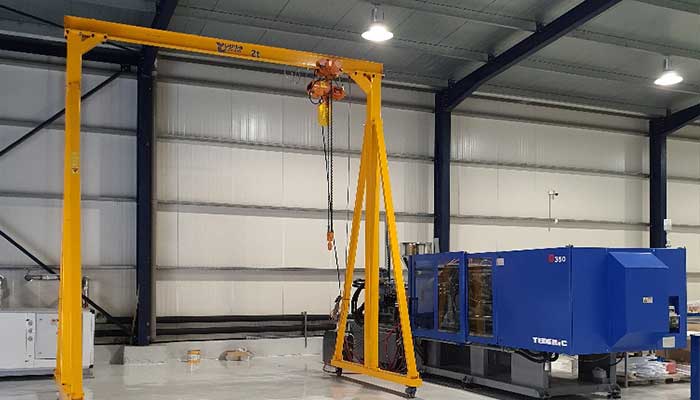
Workstation Gantry Cranes:
Design:
- Structure:Workstation gantry cranes have two upright legs (gantry) supporting a horizontal beam (bridge) that moves along the legs.
- Mobility:Some types are portable with wheels, while others are fixed in a specific location.
Applications:
- Usage:Often employed in various industries for lifting and positioning loads with precision within confined workspaces.
- Versatility:Suitable for tasks requiring precise movement and positioning of heavy materials or equipment.
Flexibility:
- Adjustability:Can have adjustable heights or modular designs for customization.
- Portability:Portable models offer flexibility in moving to different areas within a facility.
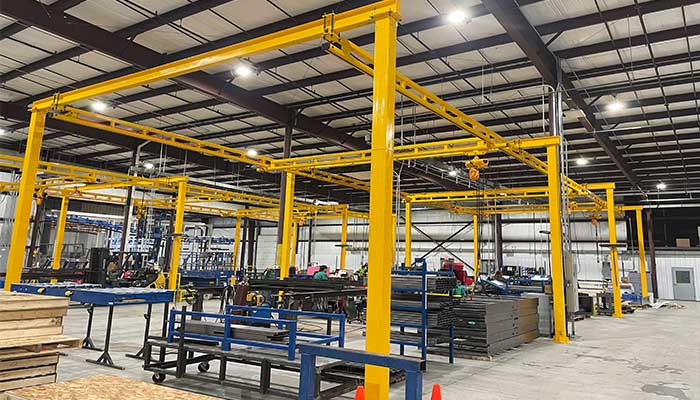
Workstation Bridge Cranes:
Design:
- Structure:Workstation bridge cranes consist of a bridge that moves along an overhead fixed runway supported by the building's structure.
- Mobility:Fixed on a runway; does not move laterally across a space like gantry cranes.
Applications:
- Usage:Commonly used in industrial settings, especially assembly lines or manufacturing operations requiring repetitive and continuous lifting tasks.
- Coverage:Provides a larger coverage area compared to gantry cranes due to the fixed runway.
Load Handling:
- Heavy Loads:Often equipped to handle heavier loads with higher capacities.
- Continuous Operations:Suited for continuous operations along a fixed path within a workspace.
Comparison:
- Mobility: - Gantry cranes offer more mobility and flexibility in terms of relocating within a workspace compared to bridge cranes, which are fixed on an overhead runway.
- Coverage Area: - Bridge cranes provide a larger coverage area due to their fixed runway setup, while gantry cranes cover a more limited area where they are positione
- Load Handling and Capacity:- Workstation bridge cranes typically have higher load capacities and are often used for heavier lifting tasks compared to gantry cranes.
- Versatility and Precision: - Gantry cranes are more versatile in terms of adaptability and precision in confined spaces, making them suitable for various tasks, while bridge cranes excel in continuous, repetitive tasks within a larger workspace.
Choosing between workstation gantry cranes and workstation bridge cranes depends on the specific requirements of the industry, the nature of lifting tasks, available space, and desired functionalities within the workspace.
Application Areas for Workstation Gantry Cranes
Workstation gantry cranes, renowned for their precision and adaptability, find extensive application across diverse industries, facilitating efficient material handling and precise load positioning. Their versatility makes them indispensable assets in various operational settings.
- Manufacturing: Assembly Lines and Precision TasksIn manufacturing environments, workstation gantry cranes play a pivotal role in assembly lines and precision tasks. They facilitate the smooth and precise positioning of components, aiding in the assembly of intricate machinery or products. These cranes contribute to streamlining production processes, enhancing productivity, and maintaining consistent quality standards.
- Warehousing: Logistics and Inventory HandlingWithin warehouse settings, workstation gantry cranes efficiently manage logistics and inventory handling. They assist in loading and unloading tasks, swiftly moving materials from storage to transportation or designated areas. Their ability to navigate through aisles and reach heights for stacking or retrieving items optimizes space utilization and expedites inventory management.
- Maintenance and Service FacilitiesMaintenance and service facilities benefit significantly from workstation gantry cranes. These cranes aid in lifting and positioning heavy machinery or components during maintenance, repairs, or equipment servicing. They provide technicians with the precision required to access and work on equipment effectively, ensuring swift and safe maintenance procedures.
Varied Industry-Specific Uses Showcasing Precision
Workstation gantry cranes showcase their precision across various industry-specific applications. For instance:
- In automotive industries, they facilitate engine or transmission assembly with precision.
- Within the aerospace sector, gantry cranes assist in positioning aircraft components during assembly or maintenance.
- Pharmaceutical industries utilize these cranes for precise handling of materials in sterile environments.
- Steel fabrication plants rely on gantry cranes for accurate placement of heavy steel structures or materials.
The adaptability and precision of workstation gantry cranes transcend industry barriers, catering to the specific needs of manufacturing, warehousing, maintenance, and a plethora of industry-specific tasks. Their ability to handle various loads with precision positions them as indispensable tools across a wide spectrum of operational environments, ensuring efficient material handling and optimized workflows.
Workstation Gantry Cranes by Capacity
Workstation gantry cranes, available in various load capacities, cater to diverse industrial needs with precision and efficiency. The differentiation based on load capacity allows industries to select cranes that align with their specific lifting requirements.
Compact Efficiency: 1-Ton Workstation Gantry Cranes
- Features:These cranes offer compact yet robust designs capable of handling loads up to 1 ton. They prioritize maneuverability and ease of use in confined spaces.
- Applications:Suited for tasks where precision and compactness are essential, such as small-scale manufacturing, workshops, or maintenance areas. Ideal for lifting smaller machinery parts or components with precision.
Versatile Precision: 2-Ton Workstation Gantry Cranes
- Features:With increased capacity, 2-ton gantry cranes maintain versatility and precision while handling heavier loads efficiently.
- Applications:Widely utilized in assembly lines, warehouses, and mid-sized manufacturing facilities where moderate lifting capacities with precision are require Suitable for handling larger components or materials during production or logistics operations.
Heavy-Duty Solutions: 5-Ton Workstation Gantry Cranes
- Features:These cranes boast higher load capacities, emphasizing heavy-duty lifting capabilities while maintaining precision and stability.
- Applications:Commonly employed in heavy industries such as steel fabrication, foundries, or larger manufacturing units where handling bulkier materials or equipment is routine. Ideal for lifting substantial machinery parts or large-scale components with precision.
The categorization of workstation gantry cranes based on load capacities allows industries to select cranes that align precisely with their lifting needs. Whether handling lighter loads with precision or maneuvering heavier materials efficiently, these cranes offer tailored solutions, ensuring optimized material handling operations across a spectrum of industrial applications.
Technological Advancements and Customization Options
Workstation gantry cranes continue to evolve, integrating cutting-edge technologies and offering customization options to meet the diverse and evolving needs of modern industrial environments. These advancements enhance efficiency, safety, and adaptability in material handling operations.
Wireless Control and Remote Operations
- Features:Incorporating wireless control systems allows operators to maneuver gantry cranes remotely, enhancing flexibility and safety. Remote operation capabilities enable operators to control crane movements from a safe distance.
- Applications:Ideal for situations where direct control might be unsafe or for precision operations that require clear visibility, wireless control ensures seamless and precise handling of materials or equipment.
Modular Systems: Tailored Solutions for Specific Needs
- Features:Modular workstation gantry cranes offer customizable configurations, allowing industries to adapt the crane's span, capacity, or functionalities based on specific requirements.
- Applications:Suited for industries with unique lifting demands, modular systems allow for tailor-made solutions, ensuring optimal performance in diverse operational scenarios.
Integration of IoT, Automation, and Precision Technologies
- Features:Integration of IoT (Internet of Things), automation, and precision technologies enables data-driven insights, predictive maintenance, and automated operations.
- Applications:IoT-driven systems allow for real-time monitoring, predictive maintenance scheduling, and performance optimization, ensuring optimal crane efficiency and minimizing downtime.
Technological advancements and customization options in workstation gantry cranes redefine the landscape of industrial material handling. Wireless control and remote operations enhance safety and maneuverability, while modular systems cater to specific needs, offering flexibility in configurations. Integration of IoT, automation, and precision technologies ensures data-driven insights and optimized performance, paving the way for smarter, safer, and more efficient material handling operations. These innovations enable industries to streamline processes, improve productivity, and adapt to the dynamic demands of modern workplaces.
Safety Measures and Environmental Considerations
Safety is paramount in industrial settings utilizing workstation gantry cranes. Additionally, environmental considerations play a vital role in modern workplaces. Implementing robust safety measures and eco-friendly practices in gantry crane operations ensures a secure working environment while reducing ecological impact.
Load Limiters and Safety Devices for Precision and Safety
- Load Limiters:These safety devices prevent overloading by automatically stopping or reducing crane operations when the load reaches or exceeds safe limits. They ensure both precision in handling and safeguard against accidents due to overloading.
- Safety Devices:Incorporating additional safety features like emergency braking systems, limit switches, and anti-collision devices further enhances operational safety, preventing accidents or collisions during crane operations.
Eco-Friendly Aspects of Electric-Powered Workstation Gantry Cranes
- Electric-Powered Cranes:Workstation gantry cranes powered by electricity offer eco-friendly advantages over traditional fuel-powered options. They produce zero emissions and reduce the carbon footprint in industrial settings.
- Energy Efficiency:Electric-powered cranes are designed to be more energy-efficient, optimizing power consumption and reducing overall energy costs. This efficiency contributes to a more sustainable work environment.
Incorporating stringent safety measures, such as load limiters and various safety devices, ensures a secure working environment while maintaining precision and efficiency in workstation gantry crane operations. Furthermore, the shift towards electric-powered cranes aligns with eco-friendly initiatives, reducing carbon emissions and promoting sustainability within industrial facilities. Prioritizing safety and environmental considerations not only safeguards personnel and equipment but also contributes to a more sustainable and responsible industrial landscape.
Installation, Maintenance, and Longevity
Ensuring proper installation, regular maintenance, and adherence to precision guidelines are pivotal for the longevity and efficient operation of workstation gantry cranes. Implementing best practices in installation and maintenance guarantees safety, optimal performance, and prolonged lifespan of these essential industrial tools.
Installation Best Practices for Precision and Stability
- Foundation and Alignment:Ensuring a robust and level foundation is crucial for stability and precision. Precise alignment of the crane components during installation guarantees optimal performance and load-bearing capacity.
- Correct Assembly:Following manufacturer guidelines meticulously during assembly and installation avoids structural errors and enhances overall stability, contributing to the crane's precision in operations.
Proactive Maintenance for Longevity and Efficient Operations
- Scheduled Inspections:Implementing regular inspections and maintenance routines is essential. Checking for wear and tear, lubricating moving parts, and inspecting safety features are integral for longevity and safe operations.
- Timely Repairs:Addressing any identified issues promptly ensures the continued efficiency and safety of the crane. Timely repairs prevent potential breakdowns and maintain optimal functionality.
Tips for Ensuring Precision in Operations and Inspections
- Operator Training:Providing comprehensive training to crane operators ensures they understand the intricacies of the crane's functionalities, enhancing precision during operations.
- Regular Calibration:Periodic calibration of control systems and load-bearing components maintains precision in load handling. Conducting regular inspections verifies crane precision and safety.
Adhering to best practices during installation, conducting proactive maintenance, and ensuring precision in operations and inspections are critical for maximizing the lifespan, efficiency, and safety of workstation gantry cranes. Proper installation guarantees stability and precision, proactive maintenance ensures longevity, and precision in operations with regular inspections enhances safety and efficiency. By prioritizing these aspects, industries can optimize the performance and lifespan of their gantry cranes, ensuring safe and efficient material handling operations.
Comparison and Case Studies
Examining workstation gantry cranes in comparison to other systems and exploring real-life case studies showcase the unique advantages, precision, and efficiency offered by these cranes in various industrial scenarios.
Comparing Workstation Gantry Cranes with Other Systems
- Versatility and Mobility:Compared to overhead bridge cranes, workstation gantry cranes offer greater mobility and versatility, especially in confined workspaces.
- Precision Handling:Gantry cranes, compared to jib cranes, provide superior precision in handling loads due to their horizontal and vertical movement capabilities.
- Customization and Adaptability:In comparison to monorail systems, workstation gantry cranes offer more adaptability and flexibility for handling various load sizes and configurations within a smaller operational are
Real-Life Case Studies Showcasing Precision and Efficiency
- Manufacturing Sector Case Study:A manufacturing plant utilized a workstation gantry crane to improve assembly line efficiency. Precision handling of components reduced assembly time by 30%, enhancing overall productivity.
- Warehousing Case Study:A logistics company implemented workstation gantry cranes for inventory handling. The precision in loading and unloading tasks reduced errors by 20%, streamlining warehouse operations.
- Maintenance Facility Case Study:An aircraft maintenance facility employed gantry cranes for engine maintenance. The precision in positioning the engine components decreased repair time by 40%, improving overall service efficiency.
Comparing workstation gantry cranes with other systems highlights their unique advantages, particularly in terms of versatility, precision handling, and adaptability. Real-life case studies across different sectors further underscore their efficacy in enhancing efficiency, reducing operational time, and improving overall productivity. These examples illustrate how workstation gantry cranes stand out as indispensable tools, contributing significantly to enhanced efficiency and precision in various industrial operations.
Embracing Precision with Workstation Gantry Cranes
As we conclude our comprehensive exploration of workstation gantry cranes and their impact on industrial operations, emphasizing precision as their hallmark, it's essential to recap their core aspects, consider crucial factors for buyers/users, and contemplate future trends in precision technologies for these cranes.
Recap of Precision as the Core Aspect
Workstation gantry cranes, distinguished by their precision, offer a fundamental advantage in material handling operations. Their ability to maneuver loads with exactness and accuracy within confined spaces defines their essence. Precision underpins their efficiency, contributing significantly to streamlined workflows, reduced errors, and consistent quality across diverse industries.
Final Considerations for Buyers/Users Focusing on Precision
For buyers/users aiming for precision-centric solutions:
- Assess Specific Needs:Identify precise lifting requirements, spatial constraints, and operational demands before selecting a gantry crane.
- Prioritize Safety:Ensure safety features align with precision needs, emphasizing load limiters, safety devices, and compliance with safety regulations.
- Evaluate Precision Technologies:Opt for gantry cranes integrating advanced technologies, wireless controls, and automation for enhanced precision and efficiency.
Future Trends in Precision Technologies for Workstation Gantry Cranes
Looking ahead, the future of workstation gantry cranes is poised for advancements:
- IoT Integration:Continued integration of IoT for predictive maintenance, data-driven insights, and performance optimization.
- Automation and Robotics:Adoption of automated systems and robotics for even greater precision and efficiency in material handling.
- Enhanced Control Systems:Advancements in control systems for finer precision and seamless operations.
Workstation gantry cranes epitomize precision in motion, becoming indispensable assets in diverse industrial sectors. As industries evolve, embracing precision-driven technologies in material handling operations remains pivotal. By emphasizing precision as a core aspect, considering buyer/user considerations, and envisioning future trends in precision technologies, the continued integration of workstation gantry cranes promises to elevate efficiency, safety, and productivity across industrial landscapes. Embracing precision isn't merely a choice but a pathway toward optimizing industrial operations in the era of technological innovation.




